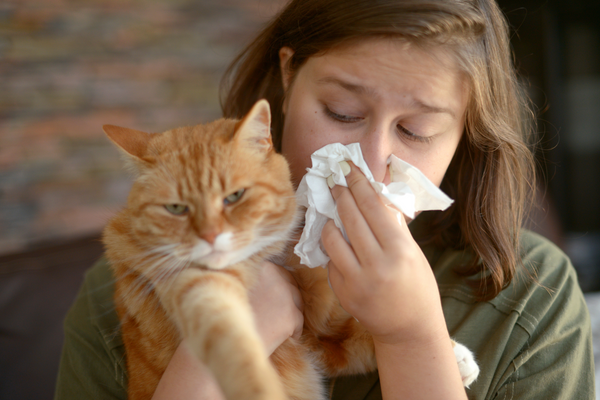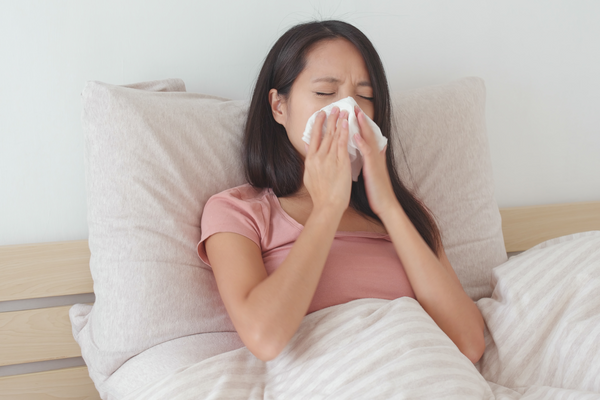These Household Allergens Could Be Messing With Your Sleep. Here’s How to Combat Them

Sneezing, wheezing, sniffling, and itchy, watery eyes aren’t the only unfortunate side effects that come with allergies. Disturbed slumber is a side effect, too, and it’s a serious one at that. Inadequate sleep can lead to fatigue, memory problems, depression, decreased productivity, and more. Chronic allergies can even increase your risk of obstructive sleep apnea. In the name of a good night’s rest – and the health and well-being that comes as a result – it’s crucial to win the battle against allergy symptoms and the allergens that trigger them.
How Allergies Affect Sleep
Allergic rhinitis is an allergic reaction to tiny particles in the air called allergens. When you breathe in allergens through your nose or mouth, your body reacts by releasing a natural chemical called histamine. Allergy symptoms can include sneezing, nasal congestion, and irritation of the eyes, nose, throat, and mouth. These aggravating symptoms narrow airways and create subsequent breathing trouble, making it terribly difficult to sleep through the night. Some people experience seasonal allergic rhinitis (sometimes called “hay fever”), usually set off by airborne particles from plants, grass, and trees. But if your allergy symptoms are year-round, there may likely be allergens lurking inside your home.
Common Household Allergens & How to Combat Them
After you’ve identified the allergens that are triggering your allergy-related sleep issues, you’ll be able to take steps to minimize symptoms and bring back those good ZzzZzz’s.
Dust Mites
Dust mites are the most common indoor allergen. These pesky little critters are unfortunate but unavoidable (and uninvited!) guests in everyone’s home. Dust mites themselves aren’t the central problem; it’s their waste and decaying bodies, which contain a protein that mixes with household dust and enters the lungs when we breathe, triggering allergic reactions and asthma symptoms for at least 10% of the population. You may have a dust mite allergy and not even know it. If you suffer from year-round allergies and are losing sleep as a result, it’s worth a trip to your doctor or allergist to determine whether or not you’re allergic to dust mites.
As their name implies, dust mites make their home in dust, but you may not know that they feed off the dead skin cells that we shed and thrive in warm, moist environments. This is why your bed and pillows are their favorite place to call home. Not-so-fun fact: A typical used mattress can have anywhere from 100,000 to 10 million dust mites living in it. Not only that but 10 percent of the weight of a two-year-old pillow may be made of dead mites and their feces. Dust mites also gravitate to areas where dust settles, such as underneath furniture. It’s impossible to banish mites from your home completely, but by upping your cleaning game, you can significantly reduce dust mite populations and their allergens and effectively neutralize their threat. Here are a few quick dust mite fighting tips:
- Once a week, wash your mattress cover, sheets, pillowcases, and blankets with an Anti-Allergen Laundry Detergent to kill dust mites and remove the allergen. While your bedding is in the washer, lightly mist your bed pillows and decorative throw pillows with an Anti-Allergen Solution to eliminate allergens. Let your pillows air dry while your bedding is in the washer. Remember that washing bedding with a regular detergent is not enough to neutralize the allergen from dust mites; using the right detergent is key in the fight against mites.
- Aim to clean and remove dust at least twice a week. Rather than using a dry dusting method that can cause the allergen to go airborne, use a damp microfiber cloth to remove dust from furniture (don’t forget to clean underneath it!), shelves, windowsills, and other dust-prone areas around your home. For extra dust mite-busting power, add Vital Oxide to your cleaning regimen. You can either spray it directly onto surfaces after cleaning to remove dust and dust mite allergens or spray it onto a microfiber cloth and wipe. Vital Oxide has the unique ability to reduce allergen levels in most common household triggers significantly, dust mite allergens included. Bonus: It also neutralizes other common allergens like pet dander and molds.
- Deep clean your mattress at least twice a year, or more often if you have a severe allergy to dust mites. By far, the best method for removing dust mites and their allergens from a mattress is hot water extraction with a “rinse & vac” system, as dust mite allergens are water-soluble. Adding Dustmite & Flea Control to the hot water vacuum will help to keep dust mites from coming back. With dust mites eliminated, they can no longer produce particles that contribute to your symptoms. Keep in mind that dust mites thrive in places with high humidity, so make sure you allow plenty of time for thorough drying after using a hot water vacuum; using a fan will help to speed up your drying time.
Related: How to Easily Reduce Dust Mites In Your Home
Pet Dander
This is another prevalent indoor allergen that may be causing you to lose sleep. In the United States, as many as three in 10 people with allergies have allergic reactions to cats and dogs, with cat allergies being twice as common as dog allergies. Contrary to popular belief, allergies to pets are caused by more than just their fur. Instead, it comes down to animal dander, an otherwise harmless protein found in a pet’s skin, saliva, and urine, according to the Mayo Clinic. The allergens can then be deposited on the animal’s fur through licking. Once the hair dries, the particles can flake off and become airborne. So, that means your beloved pet can spread their dander all over your home when they roll around the living room rug, scratch behind their ears, or chase a favorite toy. Thankfully, in many cases, allergies to pet dander can be managed.
- Keep pets out of the bedroom. Airborne pet allergen levels are much higher in rooms where animals are physically present.
- Bathe pets regularly with an Anti-Allergen Pet Shampoo to remove allergens from their fur. Our Anti-Allergen Pet Shampoo neutralizes allergens in pet dander and dust mite allergens while cleaning and conditioning for an extra-soft, fresh-smelling coat. Not to mention, the 100% biodegradable plant and mineral-based formula also make our pet shampoo an environmentally-friendly choice.
- Vacuum regularly (daily if you have a pet that sheds) with a vacuum cleaner equipped with a HEPA filter to prevent the outflow of the contents (including pet allergens) that have been swept up.
- Cover furniture with washable covers or throw blankets. Use an Anti-Allergen Laundry Detergent to wash them weekly, along with other washable items (like pet beds) to provide relief for allergy sufferers.
- Use an Anti-Allergen Solution to neutralize the threat of pet dander allergens from bedding, furniture, rugs, carpeting, upholstery, pet beds, and more. Our Anti-Allergen Solution is 100% biodegradable, made with a plant and mineral-based solution. It’s also free of fragrances and other ingredients that can make allergic reactions worse.
Related: Allergic to Your Pet? Easy Tips to Prevent & Control Your Allergy
Household Chemicals
Trying to fall asleep but feeling congested? Perhaps you’re extra sensitive to the chemicals in your home. Chemical cleaners like bleach and ammonia-based cleaners, as well as perfumed household products, can be a stealth culprit. Harsh chemicals can trigger allergy symptoms and also cause irritation, making allergy symptoms even worse.
- Banish triggering chemical cleaning products from your home. With Vital Oxide, you don’t have to worry about exposing your loved ones to triggering chemicals. This all-purpose product can be used in every room in the home – from the bathroom and kitchen to the baby’s nursery and laundry room – Vital Oxide does it all. After use, Vital Oxide breaks down into simple salt.
- Look for laundry detergents that are hypoallergenic, and skip any scented laundry products like fabric softener – especially when washing your bedding and clothing.
- Remove air fresheners, candles, potpourri, and other scented items from your bedroom. Rather than covering up funky odors with synthetic fragrance, reach for a product that destroys odors, like Vital Oxide.
Related: What’s That Smell? Avoid These Big Bad Chemicals Found in Common Household Cleaners
Mold & Mildew
Like dust mites, mold is an inevitable allergen, hiding in damp areas like basements, bathrooms, and laundry rooms.
- If you have a leak, fix it immediately and dry dampened areas thoroughly within 48 hours to help prevent mold from growing.
- For extensive mold problems, consider hiring a professional who is trained in mold cleanup. Some molds are highly toxic, and even less dangerous molds can cause problems for people with allergies or those with compromised immune systems or respiratory issues. Generally, the rule of thumb is to seek the help of a professional if the mold covers ten or more square feet. Always err on the side of caution when it comes to significant mold issues.
- Clean bathrooms regularly with Vital Oxide to neutralize mold spores, focusing on corners of tile and shower curtains, both places where moisture can breed mold.
- To make your bathroom a less attractive environment for mold and mildew, consider adding an exhaust fan or using a dehumidifier to help eliminate excess moisture.
- Wash musty towels, bed linens, and other washables with our Anti-Allergen Laundry Detergent. Remember, most laundry products don’t have the right ingredients to remove mold or the odors caused by mold, leaving mold spores, stains, and funk behind.
Related: The Top 5 Myths About Mold Removal, Debunked
Have questions about reducing allergens inside your home? We have answers! The Ecology Works has been helping folks with asthma and allergies since 1993. We can help you select the products you need to live a better, allergen-free life. Check out our Instagram for more allergen-reducing tips. Need more help? Please feel free to Contact Us or message us on Facebook. No question is too small! We're here to help.




